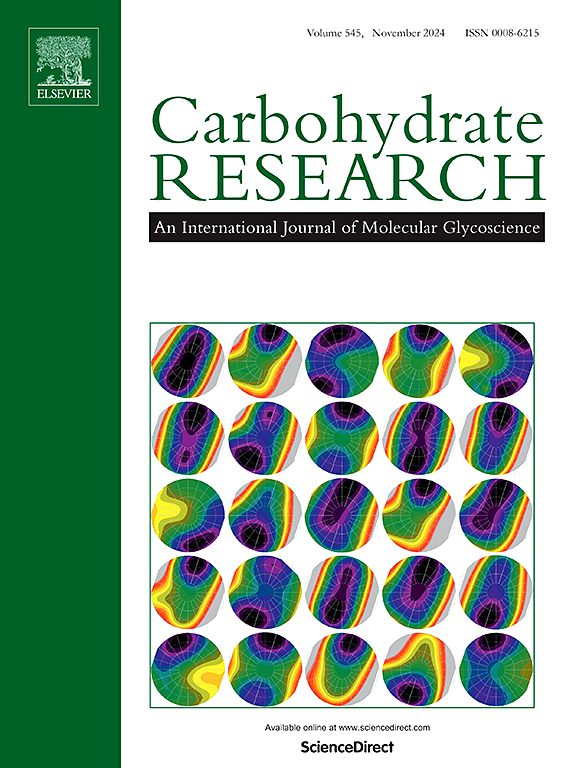Antimicrobial biodegradable packaging films from phosphorylated starch: A sustainable solution for plastic waste
IF 2.4
3区 化学
Q3 BIOCHEMISTRY & MOLECULAR BIOLOGY
引用次数: 0
Abstract
This study focused on developing biodegradable packaging films based on starch as an alternative to non-biodegradable such as petroleum-derived synthetic polymers. To improve its physicochemical properties, potato starch was chemically modified through phosphorylation. Starch phosphorylation was carried out using cyclic 1,3-propanediol phosphoryl chloride (CPPC), produced phosphorylated starch (PS), and analyzed using Fourier transform infrared (FT-IR), X-ray diffraction (XRD), Nuclear magnetic resonance (NMR), and Thermogravimetric analysis (TGA). The thermal stability of PS increased to 292 °C due to the formation of starch phosphate ester in comparison to pure starch (281 °C). Moreover, using glycerol as a plasticizer, the solvent casting method was employed to synthesize the PS/PVA biofilms. The synthesized biofilms (PPS) were further characterized using FT-IR, TGA, Mechanical testing, and Scanning electron microscopy (SEM). The result indicated that blend films have higher tensile strength (41.61 MPa) and elongation at break (240 %) than pure PVA film (29.84 MPa, 102 %). The soil burial study showed that the biodegradation of PPS blend films increased to 63.79 %. Nevertheless, the blend film showed decreased solubility, water absorption, water vapor transmission rate, and moisture content with PS, while its surface hydrophobicity increased from 61.2° to 95.6°. PPS blends have stronger antibacterial activity against S. aureus than E. coli. Accordingly, the prepared PPS III biofilm was further used for brown bread packaging. Compared to LDPE packaging, the bread wrapped in PPS III blend film exhibited enhanced visual appearance and extended shelf-life. The novelty of our work lies in the modification of starch using CPPC, which was further used to fabricate biodegradable films. Therefore, the developed biofilm may be a reference for additional research and can potentially replace synthetic, non-degradable polymer-based films in the packaging industry.

由磷酸化淀粉制成的抗菌生物可降解包装薄膜:塑料废物的可持续解决方案。
本研究的重点是开发基于淀粉的可生物降解包装薄膜,作为不可生物降解的替代品,如石油衍生的合成聚合物。为改善马铃薯淀粉的理化性质,对马铃薯淀粉进行了磷酸化化学改性。采用环1,3-丙二醇磷酸酰氯(CPPC)对淀粉进行磷酸化,得到磷酸化淀粉(PS),并采用傅里叶变换红外(FT-IR)、x射线衍射(XRD)、核磁共振(NMR)和热重分析(TGA)对其进行分析。由于淀粉磷酸酯的形成,PS的热稳定性比纯淀粉(281℃)提高到292℃。此外,以甘油为增塑剂,采用溶剂铸造法合成了PS/PVA生物膜。利用红外光谱(FT-IR)、热重分析仪(TGA)、力学性能测试和扫描电镜(SEM)对合成的生物膜(PPS)进行了进一步表征。结果表明,共混膜的抗拉强度(41.61 MPa)和断裂伸长率(240%)高于纯PVA膜(29.84 MPa, 102%)。土壤掩埋试验表明,PPS共混膜的生物降解率提高到63.79%。然而,共混膜的溶解度、吸水率、水蒸气透过率和含水率随PS的加入而降低,表面疏水性从61.2°提高到95.6°。PPS共混物对金黄色葡萄球菌的抑菌活性比大肠杆菌强。将制备的PPS III生物膜进一步用于黑面包包装。与LDPE包装相比,PPS III混合膜包装的面包具有更好的视觉外观和更长的保质期。本研究的新颖之处在于用CPPC对淀粉进行改性,并进一步用于制备生物可降解薄膜。因此,所开发的生物膜可以作为进一步研究的参考,并有可能取代包装工业中合成的、不可降解的聚合物基膜。
本文章由计算机程序翻译,如有差异,请以英文原文为准。
求助全文
约1分钟内获得全文
求助全文
来源期刊

Carbohydrate Research
化学-生化与分子生物学
CiteScore
5.00
自引率
3.20%
发文量
183
审稿时长
3.6 weeks
期刊介绍:
Carbohydrate Research publishes reports of original research in the following areas of carbohydrate science: action of enzymes, analytical chemistry, biochemistry (biosynthesis, degradation, structural and functional biochemistry, conformation, molecular recognition, enzyme mechanisms, carbohydrate-processing enzymes, including glycosidases and glycosyltransferases), chemical synthesis, isolation of natural products, physicochemical studies, reactions and their mechanisms, the study of structures and stereochemistry, and technological aspects.
Papers on polysaccharides should have a "molecular" component; that is a paper on new or modified polysaccharides should include structural information and characterization in addition to the usual studies of rheological properties and the like. A paper on a new, naturally occurring polysaccharide should include structural information, defining monosaccharide components and linkage sequence.
Papers devoted wholly or partly to X-ray crystallographic studies, or to computational aspects (molecular mechanics or molecular orbital calculations, simulations via molecular dynamics), will be considered if they meet certain criteria. For computational papers the requirements are that the methods used be specified in sufficient detail to permit replication of the results, and that the conclusions be shown to have relevance to experimental observations - the authors'' own data or data from the literature. Specific directions for the presentation of X-ray data are given below under Results and "discussion".
 求助内容:
求助内容: 应助结果提醒方式:
应助结果提醒方式:


